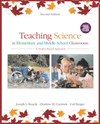 |  Teaching Children Science: A Project-Based Approach, 2/e Joe Krajcik,
University of Michigan - Ann Arbor
Charlene Czerniak,
University of Toledo
Carl Berger,
University of Michigan - Ann Arbor
How Do I Plan a Project-Based Curriculum?
Chapter Summary- There are many factors that influence teachers' decisions about the concepts and learning performances to be covered in a project:
- State and national standards.
- Adopted curricula.
- Students' interests and culture.
- After identifying concepts and selecting learning performances, teachers brainstorm several driving questions that will allow students to explore the concepts selected.
- Driving questions are
- Feasible.
- Worthwhile.
- Contextualized.
- Sustainable.
- Ethical.
- Meaningful.
- Teachers develop investigations to help students plan and conduct experiments that facilitate their construction of partial solutions to important questions.
- Various assessments that are linked to classroom activities and investigations can be used to gain a complete view of student learning.
- A calendar, although only an estimate of time, helps to guide the sequence of lessons and orchestrate the various components in a time frame.
- Some teachers like to use a concept map to organize a project's activities, because the hierarchy in the concept map helps define the sequence of concepts students need to learn in benchmark lessons.
- Teachers use many resources to help plan benchmark lessons:
- Commercial suppliers.
- Noncommercial materials.
- Everyday household materials.
- Magazines and journals.
- Teacher trade books.
- Guest lecturers, field trips, and other community resources.
- Children's literature.
- Curriculum integration is the crossing of curricular subject areas.
- Curriculum integration has become a popular reform movement for several reasons:
- It resembles real life more closely.
- National standards are calling for curriculum integration.
- Integration helps teachers teach to children's multiple intelligences.
- Curriculum integration has been found to help girls and minorities learn science.
- Project-based science supports curriculum integration because its key features (driving questions, student engagement in investigations, communities of learners collaborating together, use of technology and creation of artifacts) are all congruent with curriculum integration.
- Teachers do not integrate for the sake of integrating. Rather, they integrate across subjects to enhance learning for all students.
- Concept mapping is a useful tool for planning an integrated curriculum project.
- Technology tools help teachers plan a project-based curriculum.
|
|



 2003 McGraw-Hill Higher Education
2003 McGraw-Hill Higher Education